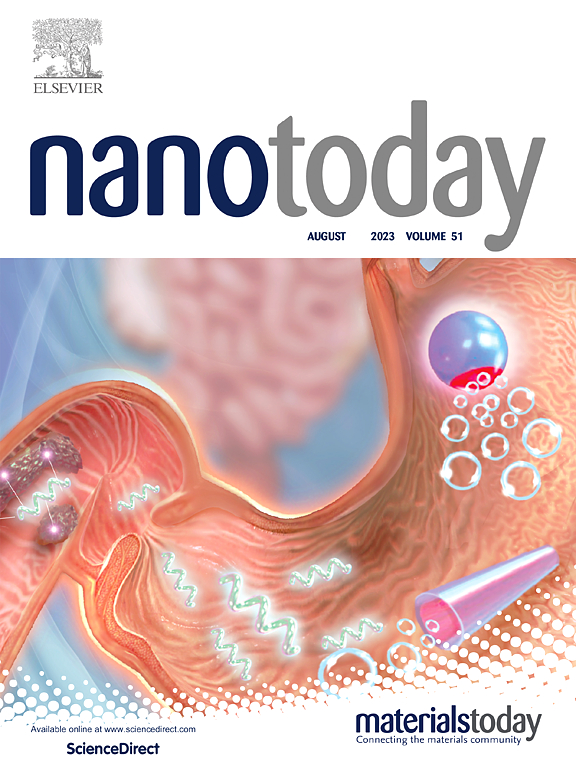Inflammation-responsive monocyte-biomimetic nanobubbles realizing microvascular recanalization and xenon neuroprotection in ischemic stroke
IF 13.2
1区 材料科学
Q1 CHEMISTRY, MULTIDISCIPLINARY
引用次数: 0
Abstract
Ischemic stroke (IS) is an acute and severed disease with vascular inflammation prior to thrombus events. Considering the current treatment strategies focus on the thrombus-target effect, reaching the early intervention and extending therapeutic time windows remains a key challenge. Herein, inspired by the monocyte infiltration mechanism to the early stroke lesion, nanobubbles encapsulating xenon with monocyte membrane shell (Xe-MNBs) are designed for emergency theranostics of IS. Xe-MNBs quickly target to the inflammatory damaged vessels and competitively inhibit the inflammatory progression via abundant membrane cytokine receptors. Afterwards, Xe-MNBs serve as a platform to recanalize microvasculature and locally deliver neuroprotective Xe in the stroke lesion, synergistically extending the “door-to-needle” streamline. In photothrombotic ischemic stroke mice, the aggregation of Xe-MNBs in stroke brains reaches approximately 8.2 times higher than normal brains within 0.5 h of stroke induction. In vivo results confirmed that blood flow perfusion, neuroprotection and inflammation inhibition can significantly improve the neurological recovery of stroke mice, also investigated by gene transcriptome analysis. This work provides a novel monocyte-biomimetic nanosystem for inflammation-responsive drug delivery and gives a proof of concept for priority management of IS with Xe-MNBs.
炎症反应性单核细胞仿生纳米泡实现缺血性脑卒中微血管再通和氙神经保护
缺血性脑卒中(IS)是一种急性切断性疾病,在血栓事件发生前伴有血管炎症。考虑到目前的治疗策略侧重于血栓靶效应,实现早期干预和延长治疗时间窗仍然是一个关键的挑战。在此,受单核细胞浸润早期脑卒中病变机制的启发,设计了用单核细胞膜壳包裹氙的纳米气泡(Xe-MNBs)用于IS的急诊治疗。Xe-MNBs快速靶向炎症损伤血管,并通过丰富的膜细胞因子受体竞争性地抑制炎症进展。然后,Xe- mnbs作为一个平台,重新通微血管,并在脑卒中病变中局部传递神经保护性的Xe,协同延长“门到针”的流线。在光血栓性缺血性脑卒中小鼠中,在脑卒中诱导0.5 h内,脑卒中脑组织中Xe-MNBs的聚集量比正常脑组织高约8.2倍。体内实验结果证实血流灌注、神经保护和炎症抑制能显著改善脑卒中小鼠的神经恢复,并通过基因转录组分析进行了研究。这项工作为炎症反应性药物递送提供了一种新的单核细胞仿生纳米系统,并为使用Xe-MNBs优先管理IS的概念提供了证明。
本文章由计算机程序翻译,如有差异,请以英文原文为准。
求助全文
约1分钟内获得全文
求助全文
来源期刊

Nano Today
工程技术-材料科学:综合
CiteScore
21.50
自引率
3.40%
发文量
305
审稿时长
40 days
期刊介绍:
Nano Today is a journal dedicated to publishing influential and innovative work in the field of nanoscience and technology. It covers a wide range of subject areas including biomaterials, materials chemistry, materials science, chemistry, bioengineering, biochemistry, genetics and molecular biology, engineering, and nanotechnology. The journal considers articles that inform readers about the latest research, breakthroughs, and topical issues in these fields. It provides comprehensive coverage through a mixture of peer-reviewed articles, research news, and information on key developments. Nano Today is abstracted and indexed in Science Citation Index, Ei Compendex, Embase, Scopus, and INSPEC.
 求助内容:
求助内容: 应助结果提醒方式:
应助结果提醒方式:


